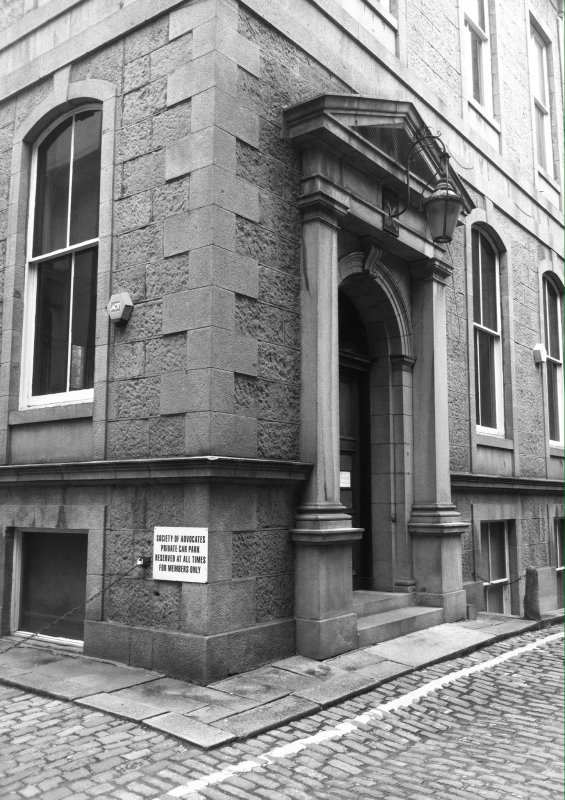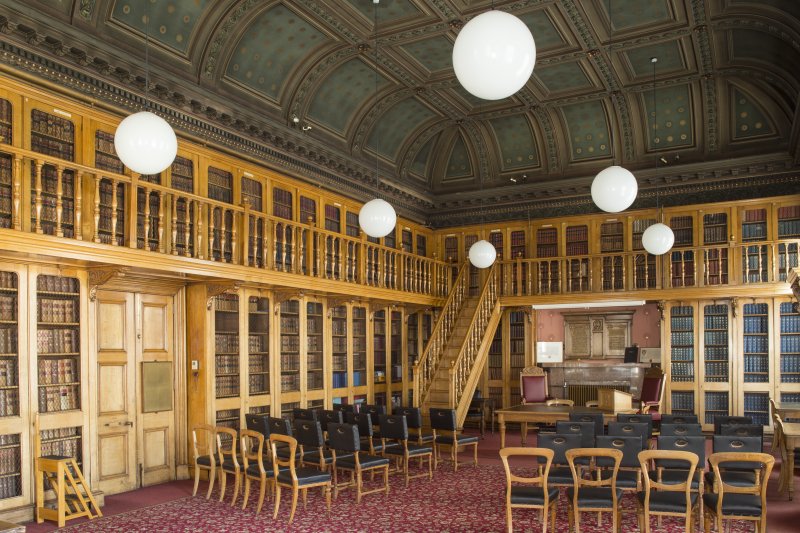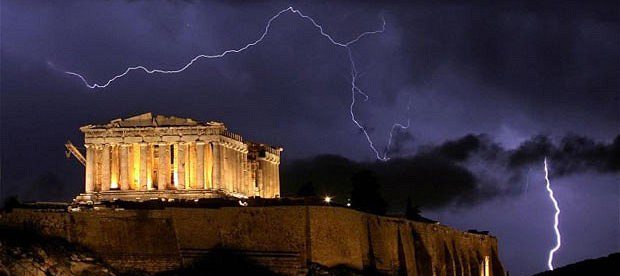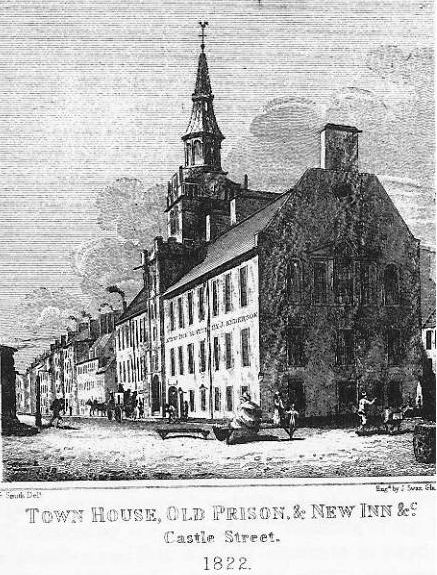The Society of Advocates
Thomas Nicolson of Cockburnspath was an Advocate Central to Aberdonian Legal Life & Practice in the early-17thC. Initially an Advocate in the Court of Session in Edinburgh, he came to Aberdeen to Serve as Judge in the Local Ecclesiastic (‘Commissary’) Court. Edinburgh was the Seat of the Great Ecclesiastical Court of the Archdeacon of the Lothians, and those who practised there were Advocates. He was later named on a Royal Commission which reintroduced Law Teaching to Aberdeen and was named as the 1st Master of Civil Law (‘Civilist’) thereafter. In 1619 re-Establishment of Law Teaching at King’s College offered a new Local perspective on a Critical Period in the development of Scotland’s Legal Profession.
The Origins of the Society of Advocates can be traced back to the 16thC. The Society draws its Membership from the Legal Profession in Aberdeen & the North East of Scotland. It includes Practising Lawyers, Supporting Professionals, Academics & Members of the Judiciary among its Ranks. History of the Society of Advocates in Aberdeen
Many hold that the Society was not formed till October, 1633, and as evidence they cite the following Order passed by
Sheriff Principal Thomas Crombie: (2nd Octopctober 1633)
The quhilk day the Shref Principall forsaid causit Call and Convein befoir him the Persones particularlie following quha ar the Ordinar Advocates and Procuratores of this Judicatorie and hes bein in use to Procuir in all causes They ar to say Mr Alexr Irwing, Mr Williame Barclay, Mr Williame Lumsden, Mr James Irwing, Mr Alexander Davidson, Mr George Andersone, Mr Alexander Reid, Mr Alexander Paip, Mr Robert Reid Alexander Thomsone, Mr Alexr Gardyn, George Middiltoun, Williame Cordoner, John Hunter Mr Andrew Clerk and George Merser Qubilkis Persones being all Personallie Present and the Shreff understanding of thair abilitie honestie and judgement to continow as Memberis Ordinar Advocates and Procuratores of this Seat. The said Shreff be wertew of his Office and Authoritie Resaiwit and Admittit them and everie ane of them to that Place and Priviledge and causit them all to be Solemlie Sworne for thair dew Obedience and Reverence to the Seat and for Faithfull and Trew Useing and Discharging of thair Place and Charge and for Obseruing of sick Guid and Laudabill Lawes, Actes, Statutes and Ordinances as sould be Sett Down and Prescrywit. And farther the said Shref Declairit and Ordainit and Expreslie Dischargit all uther Persones quhatsumewir of all Libertie or Priviledge to Compeir or Procuir befoir the Shref or his Deputtis at any tyme heireftir in quhatsumewir caus or to tak upon them to be Advocates or Procuratores except they be First Lauchfullie Admittit be the Shreff and his License and Libertie Purchessit Giwin and Grantit to that effect.

For about 300 years they had conducted their Meetings in The New Inn, the Lemon Tree Inn or the Record Office, although from 1820 they had been given the use of a Room in the New Courthouse and had Furnished it in ‘a Proper Manner‘ with Book-presses. The construction of a magnificent new Home must have been a cause of enormous Pride & Self-congratulation. The opening of their 1st Hall, which was built in 1837 to a Design by John Smith, and which stood at the Corner of Back ‘Wynd & Union Street, was the Occasion for a Formal Banquet, attended by 170-People. On this occasion, the Advocates really let their hair down. Apart from the Official Guests, each Member was permitted to bring one friend. There were 53-Toasts, and it was directed that no Toast might be proposed until the List was Exhausted. Each Member had to see to the comfort of his Friend during the evening, and one is tempted to suppose that this Instruction included the responsibility for scraping him off the Floor and carrying him Home.
Inset – Advocates Hall – A Davidson Bros. “Real Photographic” Series postcard looking east up Union Street. The image likely dates from the early 20thC. Before the Junction with Back Wynd can be seen the Queen’s Restaurant at 120 Union Street and R Hunter, Chemist at No.118.
One or 2 Members ‘Communed with the Muse‘. They Organised a Social Science Conversazione, attended by 1000-People, and caused Dancing Cloths (whatever they were – Canvas?) & Pianos to be placed in the Dining Hall, and entertained Ladies, not forgetting to lay in a stock of pins & a hairbrush. How many Members have there been of this August & Unsentimental Body? We have to go back to William Kennedy, President of the Society in 1820, who undertook to retrieve, from such Records as were available to him, as much as possible of the Society’s own Records which had been Lost in 1720, in a Fire at the Record Office. From Alexander Paip, whose date of Entry is given as 1549, until the name of the most recently admitted Member before the latest amendments to the Bye-Laws dragged the Society belatedly into the 20thC – 994 was the Total. How many Advocates there were before Alexander Paip (who must have been admitted into some previous Body of Members) will never now be ascertained, but still, the final Total cannot be far beyond 1000.
That Hall, from all accounts a beautifully appointed Building, was put up for Sale in 1870, and the old Hall became the Property of Lockhart & Salmond, Confectioners. The Confectioners ran a Restaurant in the Building until 1882 when it became a Conservative Club. This is when the curved Iron Balustraded Balcony was installed. It had become known as the Queen’s Buildings, and we may have stumbled on the explanation for the Royal Connection. Soon after the Hall was open for Business, Queen Victoria married Prince Albert. As part of the Public Celebration the Members agreed that an appropriate Transparency should be placed on the front of the Building & John Smith, the City Architect was requested to arrange it. The Hall at that time stood alone, flanked on one side by St Nicholas Churchyard, and on the other by Waste Ground. Any Decoration on such a prominent Building must have made an impression on the Citizens, and the display of a large Portrait of Queen Victoria on its Facade might easily have led to the Building’s being thereafter known as the Queen’s. It went through many vicissitudes, was externally much altered, as a Restaurant and was for a long time a Cinema before becoming a Night Club.
James Lockhart b.1819 Kirkcaldy d.1881 Aberdeen was the co-Founder with Brother-in-law John Salmond of Lockhart & Salmond, Bakers, Confectioners, Restaurateurs & Lemonade Manufacturers in various Locations in Aberdeen City from 1859-1953, last address 31-33 Forbes Street.
Originally built in 1837 as an Advocates Library & Hall. Designed by Architect John Smith in a Classical style, the building dominates a busy Corner on at 120 Union Street & Back Wynd. In 1913 it was converted into the Queen’s Cinema with a seating capacity of 580 in Stalls & Circle levels. At some time, the Auditorium was given an Art Deco style treatment. During alterations in 1928 the Foundation Stone was extracted. Enclosed within was a glass bottle Time Capsule which had been specially made in Leith and which contained Specimens of Coins, Editions of Newspapers, and the Names of the Members who subscribed to the costs of erecting the building. The Bottle was ceremonially returned to the Society, and has since vanished, along with the contents. So much for the Legal Integrity of the latter-day Members. The original elegant Interior of the Building, including the Domed Ceiling of the Hall, was destroyed in a disastrous Fire in 1927. James F Donald of Aberdeen Cinemas bought the Building in 1927 and was still its Owner at the time of the Fire and subsequent refurbishment in 1936. The Queen’s Cinema closed in 1981 and the Building later became a Nightclub known as De Niro’s, today known as Espionage which covers 3-Floors Upstairs. The Foyer is in Retail use.
Library of the Society of Advocates



No Ceremony seems to have Accompanied the Removal to Concert Court and the Opening of the New Hall. Perhaps the Advocates were too busy. Even in the vigorous Commercial confidence of the later-19thC, the Gentlemen, although they were in their Offices from 9-am until 5-pm each day, and from 7-pm until 9-pm each Evening, (Clerks who were Members of the Society of Writers were permitted to leave at 4-pm on Saturday so that they could attend their Meetings), were not averse to a little innocent diversion. They wrote Law Textbooks & Books that they considered more frivolous.
What of the Advocares Society now? Has it any Function at all, apart from the Amenity offered by its Library, (still growing, although the Books in General Literature were Sold at Auction in 1976, and the Members consequently are no longer so Enlightened), and the occasional Social Event? Steeped in the Legal Tradition the Library, still used by Members, provides a unique & highly impressive Venue at the Heart of the City. Capacity 50 people.



